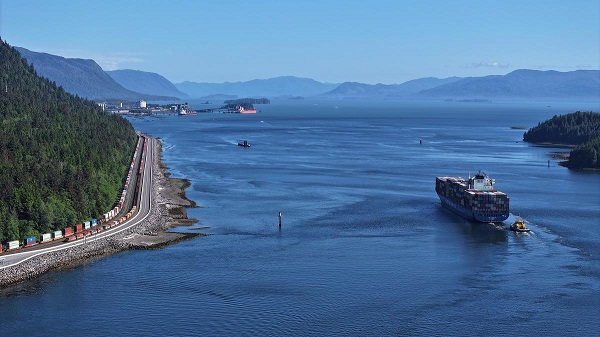espionage
Release the names! Foreign interference scandal reaching boiling point in shocking press conference

Independent MP, Investigative Reporter, Former CSIS Asia-Pacific Desk Chief shed new light on foreign interference
Press conference is hosted by (Former Liberal) Independent MP Kevin Vuong:
- MP Kevin Vuong;
- Sam Cooper, Investigative Journalist;
- Dr. Carles Burton, Senior Fellow Sinopsis;
- Michel Juneau-Katsua, Former CSIS Asia-Pacific Desk Chief.
Business
Ottawa Funded the China Ferry Deal—Then Pretended to Oppose It

While Beijing-backed hackers infiltrated Canadian telecoms, federal and B.C. leaders quietly financed a billion-dollar shipbuilding deal with a Chinese state firm—then tried to pass the buck.
So just to recap—because this one’s almost too absurd to believe: BC Ferries cuts a billion-dollar deal with a Chinese state-owned shipyard to build four new ferries. Canada’s Deputy Prime Minister Chrystia Freeland—always quick to perform outrage when the cameras are on—writes a stern letter saying how “dismayed” she is. She scolds British Columbia for daring to do business with a hostile foreign regime that’s literally attacking our critical infrastructure in real time.
And then—wait for it—it turns out her own federal government quietly financed the whole thing.
Yes, really.
According to an explosive report from The Globe and Mail, the Canada Infrastructure Bank—a federal Crown corporation—provided $1 billion in low-interest financing for the very same China shipbuilding deal Freeland claimed to oppose. The contract was signed in March 2025. The outrage? That only came later, when the public found out about it in June.

Freeland’s letter to BC’s Transportation Minister was loaded with warnings. She talked about China’s “unjustified tariffs” and “cybersecurity threats.” She demanded assurances that “no federal funding” would support the purchase. But what she didn’t mention—what she conveniently left out—was that Ottawa had already cut the cheque. The financing was already in place. The loan had been approved. Freeland just didn’t say a word.
And when reporters asked for clarification, what did her office say? Nothing. They passed the buck to another minister. The new Infrastructure Minister, Gregor Robertson, now claims the government had “no influence” in the procurement decision. No influence? You loan a billion dollars to a company and have no opinion on where it goes?
Let’s be clear: This wasn’t some harmless miscommunication. If it wasn’t a cover-up, then it was sheer incompetence—the same brand of incompetence that’s driven our shipyards into obsolescence, our economy into dependence, and our country into managed decline. An entire federal cabinet stood by, watched this unfold, signed the cheque—and then pretended they had nothing to do with it.
And British Columbia’s government? Just as bad. Premier David Eby, the man who pretends to champion “BC First,” claims he was “not happy” with the China deal but says it’s “too late” to change course. Too late? This isn’t an asteroid heading for Earth. It’s a contract. And contracts can be rewritten, canceled, renegotiated—if anyone in charge had the political will to stand up and say, “No, we don’t hand billion-dollar infrastructure projects to hostile regimes.”
But instead, we get excuse after excuse. They say BC Ferries is independent. They say there was no capacity in Canada. They say we had no choice. All the while, Canadian shipyards sit idle, unionized workers are frozen out, and the Canadian taxpayer is stuck subsidizing Chinese shipbuilding—and Chinese espionage.
Because while all of this was happening, we now know that a Chinese state-sponsored hacking group called Salt Typhoon was actively breaching Canadian telecommunications networks. That’s not speculation—it’s confirmed in a federal cyber security bulletin dated June 19, 2025.
Chinese actors exploited a vulnerability in Cisco equipment and infiltrated the networks of at least one major Canadian telecom provider. They pulled config files, rerouted traffic through GRE tunnels, and monitored call metadata and SMS communications. Translation: They were spying. On us. On officials. On infrastructure.
So let’s break this down. In February, China hacked Canadian telecoms. In March, Canada quietly finances a massive shipbuilding contract with China. In June, Freeland pretends to be outraged—while hiding the fact that her own government bankrolled it.
And now we’re told, “There’s nothing to see here. No jurisdiction.”
Really?
Freeland has jurisdiction when it comes to issuing carbon taxes, banning handguns, and lecturing citizens about disinformation—but somehow has no jurisdiction when her own Infrastructure Bank gives a billion dollars to build ships in a country that’s attacking our networks and undermining our democracy?
And it gets worse. The interest rate on the loan? Just 1.8%. That’s below market. That’s a subsidy, plain and simple. The financial gap will be recorded as government funding. So even if the Liberals want to play word games about “no direct funding,” that distinction is meaningless. The money came from taxpayers. It went to BC Ferries. It ended up in the hands of the Chinese Communist Party.
So what do we call this? It’s not economic strategy. It’s not climate policy. It’s not forward-looking infrastructure planning.
It’s decline. Managed decline.
It’s a government that tells Canadians we’re too broke, too slow, too divided to build our own ships. So we’ll just outsource it. To the same regime our intelligence services say is spying on us and interfering in our elections.
This was a test. A big one. And the people who told you they were going to put “Canada First”—people like David Eby and Mark Carney—failed that test spectacularly. When it came time to make a real choice—stand with Canadian workers, Canadian industry, and Canadian sovereignty—or cave to foreign pressure and cheap outsourcing, they chose China.
And then they lied about it.
But Canadians aren’t stupid. We know what leadership looks like—and this isn’t it. We don’t need more slogans. We need action. We need courage. We need people in government who actually believe in this country and the people who built it.
Because Canada can build ships. Canada can defend its infrastructure. And Canada should never hand over critical national projects to a regime that’s actively working against our interests.
If this is what “Canada First” looks like under the Liberals and the BC NDP, then we need something better. It’s time to stop managing decline and start building again.
Call the election. Let Canadians choose a path forward—one rooted in strength, in sovereignty, and in pride. Let us choose leaders who put Canada first—for real.
Subscribe to The Opposition with Dan Knight
Energy
China undermining American energy independence, report says

From The Center Square
By
The Chinese Communist Party is exploiting the left’s green energy movement to hurt American energy independence, according to a new report from State Armor.
Michael Lucci, founder and CEO of State Armor, says the report shows how Energy Foundation China funds green energy initiatives that make America more reliant on China, especially on technology with known vulnerabilities.
“Our report exposes how Energy Foundation China functions not as an independent nonprofit, but as a vehicle advancing the strategic interests of the Chinese Communist Party by funding U.S. green energy initiatives to shift American supply chains toward Beijing and undermine our energy security,” Lucci said in a statement before the Senate Judiciary Subcommittee’s hearing on Wednesday titled “Enter the Dragon – China and the Left’s Lawfare Against American Energy Dominance.”
Lucci said the group’s operations represent a textbook example of Chinese influence in America.
“This is a very good example of how the Chinese Communist Party operates influence operations within the United States. I would actually describe it as a perfect case study from their perspective,” he told The Center Square in a phone interview. “They’re using American money to leverage American policy changes that make the American energy grid dependent upon China.”
Lucci said one of the most concerning findings is that China-backed technology entering the U.S. power grid includes components with “undisclosed back doors” – posing a direct threat to the power grid.
“These are not actually green tech technologies. They’re red technologies,” he said. “We are finding – and this is open-source news reporting – they have undisclosed back doors in them. They’re described in a Reuters article as rogue communication devices… another way to describe that is kill switches.”
Lucci said China exploits American political divisions on energy policy to insert these technologies under the guise of environmental progress.
“Yes, and it’s very crafty,” he said. “We are not addressing the fact that these green technologies are red. Technologies controlled by the Communist Party of China should be out of the question.”
Although Lucci sees a future for carbon-free energy sources in the United States – particularly nuclear and solar energy – he doesn’t think the country should use technology from a foreign adversary to do it.
“It cannot be Chinese solar inverters that are reported in Reuters six weeks ago as having undisclosed back doors,” he said. “It cannot be Chinese batteries going into the grid … that allow them to sabotage our grid.”
Lucci said energy is a national security issue, and the United States is in a far better position to achieve energy independence than China.
“We are luckily endowed with energy independence if we choose to have it. China is not endowed with that luxury,” he said. “They’re poor in natural resources. We’re very well endowed – one of the best – with natural resources for energy production.”
He said that’s why China continues to build coal plants – and some of that coal comes from Australia – while pushing the United States to use solar energy.
“It’s very foolish of us to just make ourselves dependent on their technologies that we don’t need, and which are coming with embedded back doors that give them actual control over our energy grid,” he said.
Lucci says lawmakers at both the state and federal levels need to respond to this threat quickly.
“The executive branch should look at whether Energy Foundation China is operating as an unregistered foreign agent,” he said. “State attorneys general should be looking at these back doors that are going into our power grid – undisclosed back doors. That’s consumer fraud. That’s a deceptive trade practice.”
-

 Business1 day ago
Business1 day agoLatest shakedown attempt by Canada Post underscores need for privatization
-

 Business1 day ago
Business1 day agoWhy it’s time to repeal the oil tanker ban on B.C.’s north coast
-

 Aristotle Foundation2 days ago
Aristotle Foundation2 days agoHow Vimy Ridge Shaped Canada
-

 Alberta1 day ago
Alberta1 day agoPierre Poilievre – Per Capita, Hardisty, Alberta Is the Most Important Little Town In Canada
-

 Alberta1 day ago
Alberta1 day agoAlberta Provincial Police – New chief of Independent Agency Police Service
-

 Energy1 day ago
Energy1 day agoIf Canada Wants to be the World’s Energy Partner, We Need to Act Like It
-

 MxM News1 day ago
MxM News1 day agoUPenn strips Lia Thomas of women’s swimming titles after Title IX investigation
-

 International2 days ago
International2 days agoCBS settles with Trump over doctored 60 Minutes Harris interview







